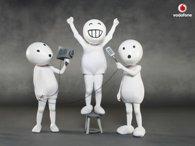 | « Back to article | Print this article |
 Vodafone's much talked about Zoozoos were in the news again. This time round it was thanks to a merchandising tie-up with Shoppers Stop, writes K V Sridhar.
Vodafone's much talked about Zoozoos were in the news again. This time round it was thanks to a merchandising tie-up with Shoppers Stop, writes K V Sridhar.
Now Zoozoo fans had the opportunity to bring the fictional, winsome characters back into their lives, as a part of their apparel and attitude.
Thinking back to the release of the Vodafone Campaign during the IPL, the response and stir created seemed almost unprecedented.
By the time the first few ads were on air, Zoozoos had mutated from television screens to laptop wallpapers, editorial features, mobile screen savers and facebook wall posts and fan pages. The campaign managed to convert consumers into fansumers, i.e. endorsers and subscribers to the brand.
The success of the Zoozoos perhaps signals the resurgence of the advertising critter or 'brand mascots' as they are commonly called.
Leo Burnett in the 70s was credited with creating some of the most memorable global mascots such as Tony the Tiger for Kellogg's, Pillsbury's Doughboy, Marlboro Man, and several others. India also saw its own successes.
The Amul girl is still synonymous with branded butter and the iconic billboards continue to be conversation starters. Air India's Maharaja is the most prolific symbol of Indian hospitality. And Onida's green-tailed man helped bring stature to the brand.
However, with the growth of television, 30 second messaging took over and slowly steered away from exploring the potential of critters.
Today, in the era of cluttered and fragmented media, Zoozoos have proved critters or mascots are now more relevant than ever before.
Critters help keep a campaign alive and effective, well after their demise of mass media. The primary reason for the same is the transition from single screen consumption to multi screen browsing.
Gone are the days when television was the only means to reach the audience. Today, the avenues to build a relationship with your target groups has multiplied. The 360 degree marketing outlook brings the mascot back into the driving seat.
Global case studies in the present day lend support to this. The phenomena of Hello Kitty, its wide spread success in Japan and its zealous fan following is well documented.
More recently Disney's efforts to create the hero halo and revamp the image of fading hero Mickey Mouse are a step in the right direction. It'll be interesting to see which brand spots a relevant opportunity and gives birth to the next advertising icon.
(The author, better known as Pops, is National Creative Director, Leo Burnett.)